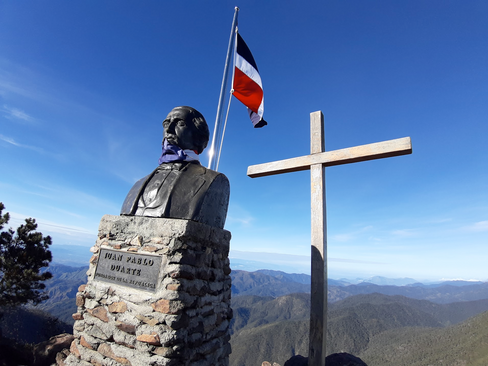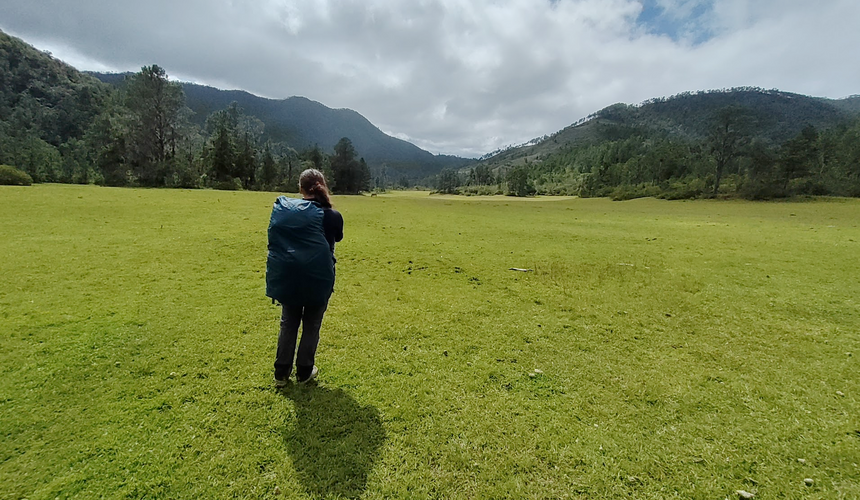At 3103m, Pico Duarte is the highest peak in Dominican Republic, and in all the Caribbean and it's really easy to reach! Here is what we did, and some advice on how to prepare so you can have as much fun as we did

There are several ways to climb this mountain, we chose the one that seemed the easiest for us. We planned the hike based off information we have found online, just to discover that a lot of information was wrong (we planned to pass through an unpassable place). So it is always better to be flexible with your plan.
The hike to the peak and back can be done in two days, but the national park offers more things to see than just the peak, so we did four days of hiking, one day to reach there, and another day that we wasted because of poor planning.
So let's start!
First, things you need to know
You cannot do the hike by yourself. By Dominican law you have to hike in the national park with a guide.
A guide comes with a mule. Most of the guides will try to make you pay for two mules, one for emergency (which is mandatory by the same law), and one for either you or your backpacks. The latter is not mandatory, no matter how hard they will try to convince you, it is possible to do the hike with one guide and one mule.
It is your responsibility to feed your guide, they will tell you that as well, and they eat a lot. You can either bring more food with you, or just give your guide some money to buy their own food.
You can book the whole trip through a tour agency, prices started around 200$ per person per day when we were there (November 2021). We did our trip for a total of 200$ for four days, for the two of us. Therefore, I would argue that the better way to do it is not through the tour agencies.
There are plenty of independent guides that will be glad to take you up, some of them can even take care of accommodation for you before and after the hike, or pick you up and drop you off wherever you want, for an additional fee of course.
It is possible to arrive to the park without a guide and the park guardian can try to find you a guide that is available. This is up to your luck, you might waste some time waiting.
The high season for hiking the mountain is December-January, as this is the only place on the island that can generate snow, the locals are rushing to it in the winter and it can get up to 1000 people a month that are hiking the mountain. In the off-season (which is the rest of the year) that number drops to 10-15 hikers per month. You decide which season you prefer.
We wanted to be as independent as possible, so we did all the transportation by ourselves, hired a guide with one mule, and gave him money to buy his own food (as we are used to packing light and not bringing too much food). We chose to start our hike from La Ciénaga, which is considered as the easiest park entrance to access. We did not know that we need a guide, and how the transport is working, so we lost one day on waiting.
Our preparation
Lucy planned a four day hike for us, we packed all of our equipment and went out. We started our journey from Santo Domingo.
We took a bus to Jarabacoa and in that bus, we discovered that we have to have a guide by randomly speaking to a friend, which changed our plans only slightly, we managed to get the number of a local guide in the three hour bus and book him last minute. In Jarabacoa we stayed the night in the cheapest hostel we could find, and we found out that there is public transport from the town center in the morning. We did not wake up extremely early, and we left the hostel around 10am.

We arrived to the town center to discover that this "public transport" is just a guy with a pickup truck that lives in La Ciénaga and does this as a service to the village people mostly to bring them things from the town and driving whoever fits the schedule, but hey, riding on a back of a pickup truck is fun, so we went for it and got on around 11am. After approximately an hour ride we arrived to La Ciénaga, and we made sure that the driver is driving the day that we are planning to return, he said that his last ride on that day will be around 1pm, so we should wait for him on the road before that time (we had no reception anywhere in the area).
We got to the national park entrance, met our guide, that told us that is already too late to leave for the peak today, so we have to start the next day. We showed him our planned trip and he said that it was not possible to do because one of the routes that the map showed us does not exist. We changed our original plan to the route that I'll describe in this post, 23km shorter than we initially planned. We spent the night there after paying the entrance fee to the park. We spent the day dipping in the (very cold) river, and the evening hanging out with the locals in the village (they know how to throw a party!)
The Hike
The stats:
57km | 4 days | Max alt: 3103m | Min alt: 1114m | Ascent: 3649m | Descent: 3646m
The route:
Day 1 - From point 1 to point 2 | 17km | 7hr
We started walking first thing in the morning, the hike itself is not very hard, the hardest part was avoiding stepping in mule shit. There is not much to see on the way up, we met the only other hikers that day, some school kids coming down from the mountain and a couple of Czech guys that got convinced to pay for a second mule so they were practically running up the mountain. On that note, our guide has told us that we are the first people that he ever saw to carry their own backpacks on their backs. Towards the end of the day we arrived to La Compartición (point 2), it is a mountain shelter, and the main stop on the way up the mountain. There is a park guardian living there, there is a hut in which people are sleeping to protect themselves from the cold night wind, we also built our tent inside for further warming. There is also a stone kitchen on which you can prepare some rice and maybe barbecue something. There is another mountain hut further up (about 30 minutes from the peak) but we arrived too late to think about going there, and it is also a lot colder and doesn't have a kitchen. We met our new Czech friends again, and had dinner and rum around the fire. There are two options for the morning, either getting up VERY early and go up the peak to watch the sunrise, or just wake up whenever and go. We, of course, decided to do the latter.
Day 2 - Point 2 to point 5 | 10.5km | 4.5hr
What happens usually is you go to the peak and then go back and finish your hike (so total of two days for the peak and back). We had time to spare, so we decided just to go to the peak and return to our tent and call it a day. We woke up around 6am and went up. We met our Czech friends on their way down, they said that a sunrise on peak was worth it, but they had to wait quite a lot for the fog to pass until they actually could see anything. After 2 hours of hike we arrived to the top seeing the flagpole and the head of Juan Pablo Duarte (after whom the peak is called), and the view from up there was incredible!
We hung out there for about an hour, ate our breakfast and started to head down after we got too cold (it's windy!). On the way back we stopped by the other mountain hut (and were very glad we decided not to camp there as it was A LOT colder). We went back to our camp (point 2/5) and stayed there for the rest of the day. We had another dinner around the table, this time only us with our guide. The guide has told us that a lot of the local people that come up the mountain just stop in the mountain hut for a few days and have a family camping and party for a few days without ever going to the top.
Day 3 - Point 5 to point 8 | 14km | 5hr
We woke up around 6am again and started walking down, we still had time so we decided to go to Valle del Tetero (point 8) instead of finishing the hike today. The way to the valley was more of the same, but this time it was also raining which made the walking part a bit more difficult. We arrived to the valley to discover a huge green field, and after we passed it we found the hut where the people are camping. The sun went up just as we arrived so we immediately went to dip in the river. After we returned from the river there were surprisingly many more people at the camp. Apparently some cows ran away from a close by village and 8 men went out to catch them. We got a great story over dinner.
Day 4 - Point 8 to point 9 | 15km | 6hr
We wanted to be back in La Ciénaga around noon so we can catch our ride, we started walking around 5am just to be sure. The walk was ok, we already walked this whole way so there was nothing new to see. We arrived on time, a bit before noon, parted ways with our guide and went out to the road to wait for our "public transport".

The guy did not arrive. We kept sitting there in hope he will turn up, and just when we were about to give up he came from the town, at 2:30pm, after almost three hours that we were waiting for him. He, of course, did not remember that we told him that we would need a ride back and he told us that it was his last run and he won't be going to town again today. We didn't know what to do, the look on our faces probably got to him, and he just told us to wait there and he will try to organize something so it will be worth the ride for him. We waited for another hour, he returned with a car full of empty gas tanks to fill, and another person that needed a ride into town. Back of the pickup truck again for us! We arrived back to Jarabacoa, ate lunch and took the bus back to Santo Domingo.
Final thoughts
This was our first vacation on the island, what did we do? Go to the highest peak. Although we were physically prepared this time, we did not have all the information. We did manage to get a great hike out of it in the end. Feel free to do the same one, or go just to the peak, or go just to the valley (which can be reached from Constanza as well). Tell us what you thought of our adventure!
























Comments